ABSTRACT
The sesame fruits present differences on maturity due to their position on the plant stem. Thus, the objective of this paper is to evaluate the physiological quality of sesame seeds from three fruits locations on the plant stem (lower, middle and upper thirds) due to fertilizing with cattle manure (0, 20, 40 and 60 t.ha-1). We evaluated the germination percentage, first germination count, germination speed index, average germination time, accelerated-aged seeds germination and electrical conductivity of seeds. In addition, to evaluate seedling establishment we observed emergence percentage, emergence speed index, and average emergence time, as well as length and dry mass of seedlings. The experimental arrange used was entirely randomized in a factorial scheme (3×4) with four repetitions, and means were compared through the Tukey test at 5% probability. The fruits position on the plant stem influenced the sesame seeds quality. The yellowish green fruits from middle third of stem, as well as yellowish ones from lower third of stem showed best results for most variables evaluated. Seed vigor was positively influenced by cattle manure application in the soil; however, fertilizing did not have any effect on seeds germination.
Key words: Sesamum indicum L., germination, organic agriculture, seed maturation, seeds vigor.
The sesame (Sesamum indicum L.), belongs to Pedaliaceae family. The crop inserts itself in both conventional cultivation systems and in agroecological production system. Due to its drought tolerance and ease of cultivation, this crop presents high potential to be grown in succession, rotation and intercropping with other ones. On the last years sesame has drawn interest from farmers who seek alternatives to diversify agricultural activities and from costumers who look for high nutritional value products. It is a plant that grows in diverse types of soils, regions and environment conditions. However, to a satisfactory performance it is necessary to provide good soil-water-plant relations (Cagrgan, 2006; Perin and Cruvinel, 2010). The sesame is a crop with low input use, which is easy to handle and insert itself in the principles of small farmers production (Cagrgan, 2006).
This crop has as main product the grain (seed). It is eatable, provides oil and flour, besides having important nutritional features, such as vitamins A, B and C, good calcium content, phosphor and iron. In Brazil, sesame has a growing market for exploration of its grains and oils, which can be used to a variety of food products and phytotherapy products (Queiroga et al., 2008). Thus, facing the relevant increase of this oil crop, a high demand for quality seeds has been required as well.
Many factors influence obtaining high quality sesame seeds, being one of them the fruits harvest time. To figure out the correct time to pick up the fruits is essential, because the longer plants remain at fields after complete maturation, the higher will be seed losses during this stage. It happens because the sesame fruit maturation period lasts several weeks and when the ones from stem base are ripe they start to open themselves. However, the apical parts of main and secondary branches have fruits at early development stages. Therefore, as fruit opening occurs by itself at a fast pace, any delay at harvest period might represent sensible seed loss (Arriel et al., 1998). Determination of harvest season for sesame is hard, since maturation of capsules is not uniform, which is a characteristic of undetermined growth plants (Beltrão et al., 2001).
High quality seeds usage is fundamental to crop establishment and furthermore yields increase in tillage. It can be obtained by combination of genetic, physical, physiological and sanitary parameters. Those features influence directly a good agronomic performance and are fundamental to crop success at fields (Krzyzanowski et al., 2008). Being considered a species that exhausts the soil, there has been the need to use organic compounds as complementation or to replace mineral fertilizing due to the high prices on agricultural inputs. A well-known organic fertilizer is cattle manure. Besides suppling reasonable contents of macro and micronutrients for crop growth, it increases the organic matter quantity in the soil, being a low cost alternative to substitute mineral fertilizers (Lazcano et al., 2008).
Furthermore, it is easy to obtain both at small and large rural properties in Brazilian Northeast region because the majority of farmers also work with livestock and explore cattle production. The aim of this work is to evaluate physiological quality of sesame seeds due to organic fertilizing and fruit position on the plant stem.
The sesame seeds were obtained from plants cultivated from July to October of 2014 at Crop Science Department in Federal University of Ceará, Fortaleza, Ceará, Brazil. Local geographic coordinates are 3° 44’ S latitude, 38°33’ W longitude and altitude of 21 m. It is a tropical rainy weather, classified as AW’, according to Köppen climatic classification (1948). Annual average precipitation is 1,338 mm, with averages of minimum and maximum temperature from 23 ± 2 to 30 ± 2°C, respectively.
The soil was sandy, presenting the following characteristics: pH (in H2O) = 6.12; Ca2+ = 1.4 cmolc.kg-1; Mg2+ = 0.8 cmolc.kg-1; K+ = 0.94 cmolc.kg-1; Al3+ = 0.1 cmolc.kg-1; SB = 3.17 cmolc.kg-1; CTC = 4.17 cmolc.kg-1; P5+ = 16.1 mg.kg-1 and MO = 0.65%.We used sesame seeds cv. BRS Seda, which features light coloration, being more acceptable for seed market. The cultivar presents fast cycle and is adapted to semiarid weather conditions.Plants were fertilized with cattle manure spread in 10 cm depth furrows at 0; 20; 40 and 60 t.ha-1 doses. The cattle manure analysis provided the following characteristics: CO = 116.74 g.kg-1; N = 7.91 g.kg-1; and C:N rate = 14.6.We covered the furrow and sown seeds in pits at 2 cm depth. The plants were spaced among themselves by 0.20 cm and among rows by 0.70 cm, leaving two plants per pit after thinning (done 20 days after the seeding).The plants were daily irrigated using an aspersion irrigation system. The weed control was handled through hoeing whenever it was necessary. Experimental plots had 2.80 m wide and 5 m length, with a total area of 14 m². The experiment had 16 parcels, occupying a total useful area of 224 m².
We have done the harvest 90 days after sowing, when we picked up 12 random plants from useful area. Plants were cut around insertion height of first fruits (35 cm high from soil). After cutting the plants, the stems were taken to the greenhouse and divided in three equal parts, in such a way that each part had greenish, yellowish green or yellowish colors, corresponding to upper (U), middle (M) or lower (L) stem thirds, respectively (Figure 1).

After harvested and classified by position at plant stem, fruits were kept inside of an electric dryer with forced air circulation at 30 to 35° C for four days. Seeds moisture content was determined by hot air oven method at 105 ± 3°C for 24 h (Brasil, 2009), using two 500 seeds subsamples for each position. The results were expressed in percentage through the following calculation: MC (%) = ISW - FSW)/ ISW (× 100), where those initials stands for: MC (%) = Moisture content; ISW = Initial seeds weight; FSW = Final seed weight. For seed physiological quality, we evaluated the following variables: (1) Germination percentage (GP) - performed with four repetitions of 50 seeds, and count done at the third and sixth days after sowing, according with the established criteria on the Brazilian Rules for Seeds Analysis (Brasil, 2009); (2) First germination count (FGC) - done with the germination test; (3) Germination speed index (GSI) - seeds were daily evaluated until the last count (sixth day after seeding); and (4) Average Germination Time (AGT) - obtained through daily germinated seed count until the sixth day after sowing.
For seedling establishment evaluation we determined: (1) Seedling emergence percentage (SE) - performed with four repetitions of 50 seeds distributed in 1 m wide and 9.60 m long beds, with 0.10 m spacing between the rows and 4 cm between seeds. These evaluations were done 15 days after sowing (DAS), determining emergence seedling percentage; (2) Emergence speed index (ESI) - done through observation of the daily emerged seedling number at 15 DAS, being considered emerged the seedling that came out, opened its cotyledon and vertical stem axis; (3) Average emergence time (AET) - obtained through daily count of emerged seeds up to the 15th DAS; (4) seedling length (SL) - using a centimeter graduated ruler, measurement was performed from the base of stem to the insertion point of the last leaf originated in the apical meristem; (5) Dry seedling mass (DSM) - after measurements, the seedlings of each treatment were store in paper bags and taken to a hot air oven regulated at 65°C for 24 h and then weighted in a precision scale. The results were expressed in grams per seedling (g.seedling-1).
Seeds vigor was assessed through the following tests: (1) Accelerated aging (AA) - following Marcos Filho (1999) recomendations the seeds were distributed over the screen surface of plastic boxes containing 40 mL of distilled water, which were left in a BOD type chamber at 42°C for 48 h. After this period, germination test with four repetitions of 50 seeds was performed and at 3 DAS we counted normal seedlings, abnormal and non-germinated seedlings. The results were expressed in percentage, according to the criteria established on Brazilian Rules for Seeds Analysis (Brasil, 2009). Electric conductivity (CE) was performed using four repetitions of 50 seeds per treatment. Seeds were placed inside 200 ml cups containing 75 mL of distilled water. Those cups were kept at 25°C for 24 h and then we used a Marconi ® model MA-521 conductivimeter to get the values for this variable (Vieira and Krzyzanowski, 1999). The results were expressed in microSiemens per centimeter per gram (μS cm-1 g-1) of seeds.
The experimental design used was entirely randomized, in a factorial scheme (3×4) with four repetitions. The first factor was composed by three capsule positions (maturity of fruits) on the plant stem (lower, middle and upper third). The second factor was composed by the doses of organic fertilizer (0, 20, 40 and 60 t.ha-1).We used statistic program Sisvar (Ferreira, 2014), in order to perform the data analysis. The Tukey test at 5% was used to compare means when the maturation factor was significant, and when the dose factor was significant, regression analysis was performed using 4 biological replicates.
Freshly-picked seeds from upper third of stems presented high water content, with mean values around 69% (Table 1). These results are important indicators that they did not manage to complete their maturation. According to Piña-Rodrigues and Aguiar (1993), the water content is an indicator of seeds maturation stage. However, seeds from lower and middle third showed water content among the interval of physiologic maturation. According to Carvalho and Nakagawa (2012), that range is from 30 to 50%. After drying the fruits we verified adequate water content values to perform germination tests, once those seeds were at hygroscopic balance (Table 1).

There was a significant effect (P<0.01) of fruit position (maturation) on FGC, GP and GSI (Table 2). The dose factor, on the other hand, had no significant effect over seed germination. It differs from results found by Magalhães et al. (2010), when studying sesame seeds, cv. CNPC G3, who concluded that cattle manure doses influenced seed germination. By studying factors together (interaction between maturation and doses), it is notable that there was no significant effect for none of the analyzed variables in the experiment. It leads us to believe that fertilizing does not influence fruit maturation.
Determination of physiological maturation and ideal moment to harvest fruits are important aspects for production of high quality seeds (Martins et al., 2012). Seeds harvested from plant upper third showed low quality, noticing that these capsules did not reach physiological maturity and were not ready for harvest procedures (Figure 2). These results disagree from the ones found by Nogueira Filho (2014) when studying seed germination from three capsule positions on sesame stems. This autor worked with cultivar IAC – Ouro and did not find any difference among germination percentages due to plant fruits position.
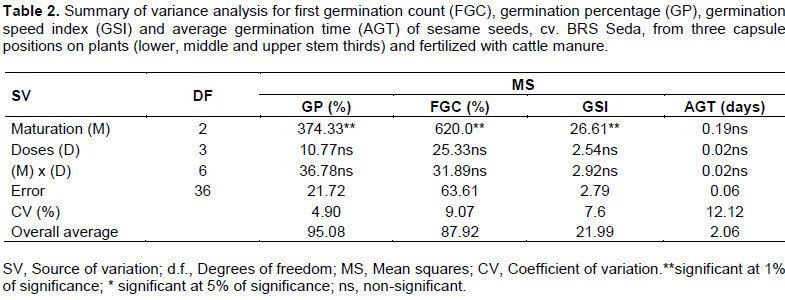
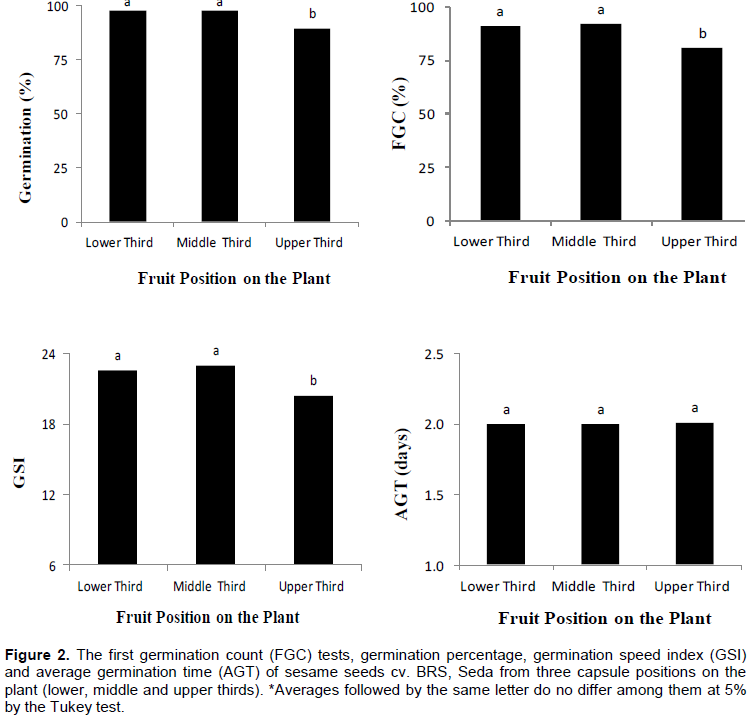
We observed that seeds harvested at lower and middle thirds did not differ among themselves for GP variable, presenting a germination percentage of 98 and 97%, respectively. It demonstrated that even yellowish green fruits (middle third) were ready to be picked up. Fruits from the upper third, however, presented 89.5% of germination, which average value, despite being lower than other thirds it is still considered reasonable for this crop. These results were better than those found by Silva et al. (2016), who observed 80 and 70% for this same cultivar seeds harvested from plants under water stress.For FCG variable, performed at third day after sown, we noticed that seeds from fruits at lower and middle plant thirds presented higher percentage of normal seedlings (91 and 92% respectively), whereas upper thirds came up with lower values (80.8%) (Figure 2). This is likely to happen because upper third stems had fruits with immature seeds yet.
According to Nakagawa (1999), the higher GSI values, the greater germination speed, allow to infer that more vigorous the seed is. Based on such information, seeds produced at fruits from lower and middle thirds are the most vigorous. On the other hand, the AGT variable did not differ between positions, taking about two days for the end of the germination (Figure 2).When it comes about SE, it is noticeable a significant effect (P<0.05) for maturation factor (Table 3). The other seedling emergence variables analyzed do not differ among themselves. Besides that, interaction between maturation and dose resulted in no significant effects for all variables.

When the sesame seeds were evaluated through SE, it was possible to observe difference among fruits positions on plant, noticing a lower seedling emergence from immature seeds (85%), which stands for seeds picked from fruits on upper third of the stem (Figure 3). Seeds from the lower and middle thirds presented 90 and 88% of emerged seedlings respectively, not statistically differing among themselves. Similar results were obtained by Lucena et al. (2013) who observed that immature seeds also presented lower emerged seedlings percentage. When studying cotton seeds vigor, Mattioni et al. (2012) verified that more vigorous seeds had upper performance at in-field seedling emergence, fact that is also observed in this paper.
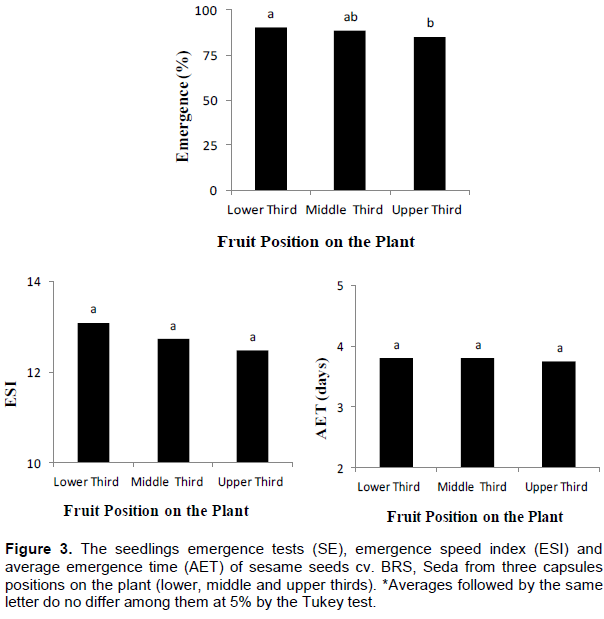
Seedlings emergence percentage in soil is a very important test for high quality seed production, because of its similarity to the field reality that seeds will face at agroecosystem environments. Thus, to figure out seeds physiology quality is very important, since using low quality seeds may affect crops yield in three ways: Less plants in field, plants less vigorous and plants with low yields (Silva et al., 2013).
ESI and AET variables did not statistically differ among harvested thirds. These results differ from those found by Lucena et al. (2013) that evaluating quality of sesame seeds harvested from fruits in different maturation stages, verified significant effect to these variables.
The variance analysis for variables SL, DSM, AA and EC is presented in Table 4. There has been significant effect (P<0.01) to all variables when the maturation factor (seeds position) was studied in isolation. Seedling length and dry seedling mass also had effect from the cattle manure dose. None of those variables were affected by interaction between factors.
Vigor tests are of great importance to a seed production program, because they complement the germination tests. It magnifies physiological knowledges of the embryo and seedling; verify influence of environmental factors; determine processing and storage effects over seeds quality and evaluate seeds maturation stage (Baskin and Baskin, 1998).
To SL data there has been a difference between capsule positions on plants, but lower and middle thirds did not differentiate among themselves. These positions provided seedlings with length of 4.74 and 4.99 cm, respectively. They were more vigorous than seedlings from the upper third, which presented average length of 3.64 cm (Figure 4). According to Nakagawa (1999), seedling length test has its base on the principle that the seeds batch which originates longer seedlings is more vigorous. The DSM followed the same behavior of previous variable (SL), confirming that larger seedlings provides, in general, higher values for dry seedling mass. The lower and middle thirds, which capsules were already ripe, originated seedlings with larger dry mass accumulation (0.73 and 0.77 g.seeling-1, respectively). Therefore, results obtained in this paper agree with Carvalho and Nakagawa (2012) report. These authors stated that seeds which are not completely ripe can germinate, but do not result in such as vigorous seedlings as the ones picked at the right maturation stage. That happens because ripe seeds present a physical and physiological development that ensures maximum vigor expression. This statement was confirmed through the length (3.64 cm) and dry seedling mass (0.57 g/seedling) from seeds in fruits at the upper third of stems. These seeds germinated, however, turned themselves in less vigorous seedlings (Figure 4).
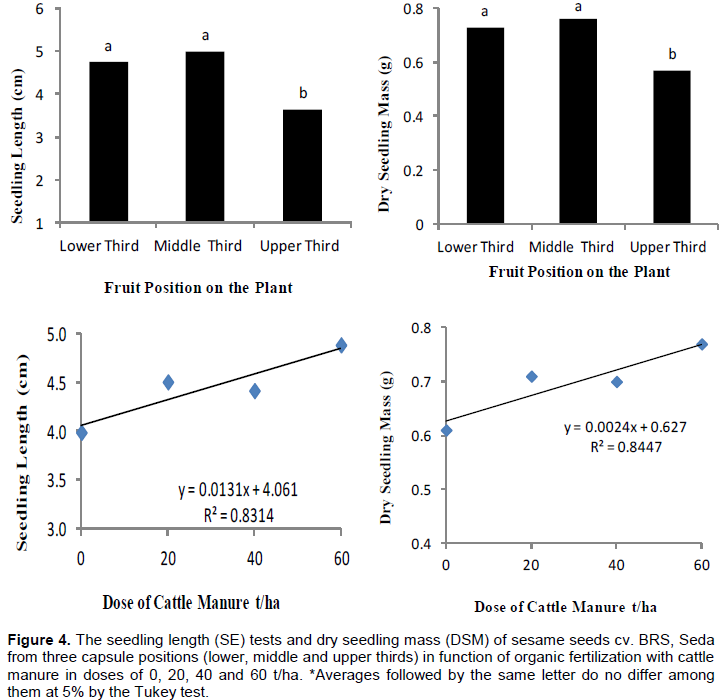
There was an increase on seedlings length as the manure doses increased, reaching maximum size (4.89 cm) for plants grown under 60 t.ha-1 of this fertilizer. These results agreed with those found by Martins et al. (2013), who concluded that cowpea seedling length was influenced by organic fertilizer application in soil.
Dry seedling mass was also influenced by manure doses. The average values varied between 0.61 g per seedling from plants without fertilization to 0.77 g per seedling for plants fertilized with 60 t ha-1 (Figure 4). This result can be explained through the benefits provided to the soil after cattle manure application, such as elevation of cation exchange capacity (CEC) and a greater balance between nutrients, which remain available to plants throughout their development (Lopes et al., 2005).
For AA variable, we realized the lower third presented higher normal seedling percentage after such vigor test (91.75%). This value fits on the pattern proposed by Albuquerque (2000), who considered as vigorous the seeds that, after the end of accelerated aging, germination percentage remain between the 87 to 93% interval (Figure 5). Seeds from middle third presented 86.75% normal seedlings. For this treatment, we observed better results than the ones obtained by Kulczunski et al. (2013). These researchers observed 85% normal seedlings after accelerated aging of sesame seeds, for cultivar, CNPA G4. Seeds from fruits at upper third of stem differed significantly from the other positions, presenting 74.75% of normal seedlings. It is likely to happen because seeds from plant apex should not yet have reached final physiological maturation stage, meaning that were not ready to be harvested.
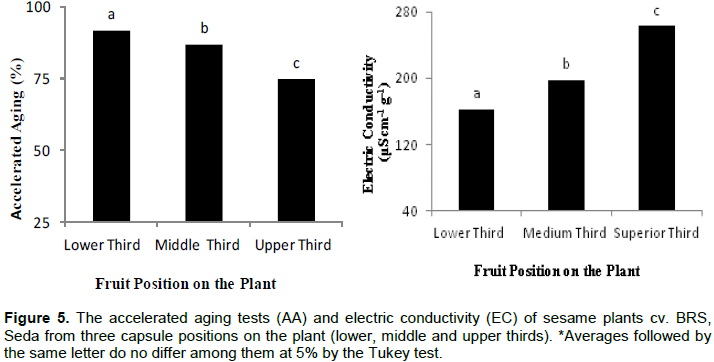
Regarding EC, similarly to variable already discussed, there was significant difference for fruits position on plant stem. Seeds from fruits on upper third position presented higher electrolyte lixiviation 24 h after soaking. The high electric conductivity average value found (263.11 μS.cm-1.g-1) in seeds from the sesame upper third indicates that these seeds were deteriorated and presented low vigor (Vieira and Krzyzanowski, 1999). It is most likely that capsules from this position on stem had larger percentage of immature seeds, which were still under development and maturation phase, so they resulted in more lixiviates (Queiroga et al., 2009). On the other hand, seeds from fruits on lower and middle third positions presented lower values (161.58 and 196.91 11 μS.cm-1.g-1 respectively). That indicated lower solute contents in soak water and, therefore, higher cell membrane integrity (Figure 5).
According to what we have observed in this experiment, the yellowish green (from middle third of stem) and yellowish (from lower third of stem) sesame capsules showed best results for most parameters evaluated. On the other hand, although seed vigor was positively influenced by cattle manure fertilization, it did not have presented any effect on seeds germination.For farmers and seed producers, the information provided in this study is important due to the descent process that occurs in the fruits of this crop. Therefore, an early harvest could avoid significative seed losses and decreases in seed quality. Our protocol indicates that producers can identify it easily through the fruits color, in this case collecting sesamum when in the yellowish and yellowish green colorations. This simple approach allows relevant improvements for sesame seed cultivation in Brazil, once the most common way of harvesting this crop is manually.
The authors have not declared any conflict of interests.
REFERENCES
|
Albuquerque MCF (2000). Desempenho germinativo e testes de vigor para sementes de girassol, milho e soja semeadas sob condições de estresse ambiental. Tese Doutorado em Produção e Tecnologia de Sementes, Universidade Estadual Paulista, Faculdade de Ciências Agrárias e Veterinárias, Jaboticabal P 180.
|
|
|
|
Arriel NHC, Andrade FP, Farias FJC, Costa IT, Guedes AR (1998). Aderência placentual das sementes e componentes de produção em progênies de gergelim. Revista Ol. Fibros. 2(2):133-139.
|
|
|
|
Baskin JM, Baskin CC (1998). Seeds, ecology, biogeography, and evolution of dormancy and germination. New York, Academic Press. 666 p.
|
|
|
|
Beltrão NEM, Pereira JR, Silva ORRF, Azevedo DMP, Vieira DJ (2001) Manejo Cultural, In: Beltrão, NEM, Vieira, DJ. (Eds tec). O Agronegócio de gergelim no Brasil, Embrapa Informação Tecnológica, Brasília –DF, 2001. Cap. 8:149-166.
|
|
|
|
BRASIL (2009). Ministério da Agricultura e Reforma Agrária. Regras para análise de semente. Secretaria Nacional de Defesa Agropecuária. Departamento Nacional de Produção Vegetal. Coordenação de Laboratório Vegetal. Brasília, DF. 365 p.
|
|
|
|
Cagrgan MI (2006). Selection and morphological characterization of induced determinate mutants in sesame. Field Crops Res. 96:19-24.
Crossref
|
|
|
|
Carvalho NM, Nakagawa J (2010). FUNEP Jaboticabal (5a ed). Sementes: ciência, tecnologia e produção 590 p.
|
|
|
|
Ferreira DF (2014). Sisvar: a guide for its bootstrap procedures in multiple comparisons. Ciência e Agrotecnolgia, Lavras. 38(2):109-112.
|
|
|
|
Köeppen W (1948) Climatologia: con un estudio de los climas de la tierra. Fondo de Cultura. Econômica México: 478 p.
|
|
|
|
Krzyzanowski FC, França Neto JB, Henning AA, Costa NPA (2008). Semente de soja como tecnologia e base para altas produtividades – série sementes. Londrina: Embrapa.
|
|
|
|
Lazcano C, Gómez-Brandón M, Domínguez, J (2008). Comparison of the effectiveness of composting and vermicomposting for the biological stabilization of cattle manure. Chemosphere. 72(04):1013-1019.
Crossref
|
|
|
|
Lopes JLW, Guerrini IA, Saad JCC, Silva MR (2005). Efeitos da irrigação na sobrevivência, transpiração e no teor relativo de água na folha em mudas de Eucalyptus grandis em diferentes substratos. Scientia Forestalis. 68(1):97-106.
|
|
|
|
Lucena AMA, Cavalcanti NTF, Farias AL, Santos KS, Arriel NHC, Albuquerque FA (2013). Qualidade de sementes de gergelim colhidas de frutos em diferentes estádios de maturação, Scientia Plena. 9(6).
|
|
|
|
Magalhães ID, Costa FE, Alves GMR, Almeida AES, Silva SD, Soares CS (2010). Qualidade de sementes de gergelim (Sesamum indicum L.) provenientes de plantas adubadas com esterco bovino. IV Congresso Brasileiro de Mamona e I Simpósio Internacional de Oleaginosas Energéticas.
|
|
|
|
Marcos Filho J (1999). Teste de envelhecimento acelerado. In: Krzyzanowski, FC, Vieira, RD, França Neto, JB (Ed.). Vigor de sementes: conceitos e testes. Londrina: ABRATES. 3:1-24.
View
|
|
|
|
Martins DC, Vilela FKJ, Guimarães RM, Gomes LAA, Silva PA (2012). Physiological maturity of eggplant seeds, Revista Brasileira de Sementes. 34(4):534-540.
Crossref
|
|
|
|
Martins JDL, Moura MF, Oliveira JPF, Gonçalves MV, Zumba JS, Oliveira M, Gonçalves EP, Silva SCA, Melo LDFA, Santos IB, Machado ROS (2013). Qualidade fisiológica de sementes de feijão-caupi cultivado com composto orgânico, biofertilizante, inoculante e adubo mineral. III CONAC- Congresso Nacional de Feijão Caupi, Recife - PE.
|
|
|
|
Mattioni F, Albuquerque MCF, Marcos Filho, J, Guimarães, SC (2012). Vigor de sementes e desempenho de plantas de algodão, Revista Brasileira de Sementes. 34(1):108-116.
Crossref
|
|
|
|
Nakagawa J (1999). Testes de vigor baseados no desempenho das plântulas. In: Krzyzanowski, FC, Vieira, RD, França Neto, JB (1999). Vigor de sementes: conceitos e testes. Londrina: Abrates. pp. 2-24.
|
|
|
|
Nogueira Filho, FP (2014). Efeito da posição dos frutos na planta sobre a germinação e o vigor de sementes de gergelim, Monografia graduação em Agronomia. Universidade Federal do Ceará, Fortaleza P 40.
|
|
|
|
Perin A, Cruvinel DJJW (2010). Desempenho do gergelim em função da adubação NPK e do nível de fertilidade do solo. Acta Sci. Agron. 32(1):93-98.
Crossref
|
|
|
|
Pi-a-Rodrigues, FCM, Aguiar IB (1993). Maturação e dispersão de sementes. In: Aguiar, IB, Pi-a-Rodrigues, FCM, Figliolia, MB (1993). Sementes Florestais Tropicais. ABRATES. pp. 215-274.
|
|
|
|
Queiroga VP, Gondim TMS, Vale DG, Gereon HGM, Moura JÁ, Silva PJ, Souza Filho JF (2008). Produção de Gergelim Orgânico nas Comunidades de Produtores Familiares de São Francisco De Assis Do Piauí. EMBRAPA-CNPA, Campina Grande, 127 p.
|
|
|
|
Queiroga VP, Gondim TMS, Queiroga DAN (2009). Tecnologias sobre operações de semeadura e colheita para a cultura do gergelim (Sesamum indicum L.). Revista Agro@mbiente. 3(2):106-121.
|
|
|
|
Silva RT, Oliveira AB, Lopes MFQ, Guimarães MA, Dutra AS (2016). Physiological quality of sesame seeds produced from plants subjected to water stress. Revista Ciência Agronômica. 47(4):643-648.
Crossref
|
|
|
|
Vieira RD, Krzyzanowski FC (1999). Teste de condutividade elétrica. In: Krzyzanowski, FC, Vieira, RD, França Neto, JB (1999). Vigor de sementes: conceitos e testes. ABRATES, Cap. 4:1-26.
|